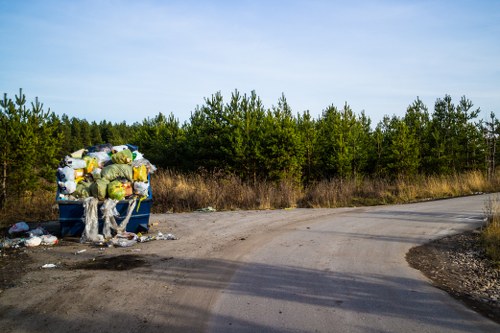Business Waste Removal in Office Clearance
Understanding Business Waste Removal

In today’s fast-paced business environment, maintaining a clean and efficient workspace is crucial for productivity and employee well-being. Business waste removal in office clearance plays a pivotal role in ensuring that office environments remain clutter-free and sustainable.
Proper waste management not only enhances the aesthetic appeal of the workplace but also contributes to environmental conservation. Companies that prioritize efficient waste removal demonstrate their commitment to sustainability and corporate responsibility.
Office clearance involves the systematic removal of various types of waste, including paper, electronic waste, furniture, and other office-related materials. Effective waste removal strategies help in minimizing the environmental footprint of businesses.
Types of Business Waste in Offices

Offices generate a diverse range of waste materials, each requiring specific management approaches. Understanding the types of waste is essential for implementing effective removal strategies.
Common types of business waste include:
- Paper Waste: Includes documents, reports, and packaging materials.
- Electronic Waste: Outdated computers, printers, and other electronic devices.
- Furniture: Office desks, chairs, and storage units that are no longer in use.
- Chemical Waste: Cleaning agents and other hazardous materials.
- General Waste: Kitchen waste, packaging, and miscellaneous items.
Each category requires tailored waste removal solutions to ensure proper disposal and recycling, thereby promoting a sustainable office environment.
Implementing a comprehensive waste management plan helps businesses efficiently handle the various types of waste generated daily.
Benefits of Professional Office Clearance Services

Opting for professional business waste removal in office clearance offers numerous advantages. These services are designed to streamline the waste removal process, making it more efficient and environmentally friendly.
Key benefits include:
- Efficiency: Professional services ensure timely and systematic removal of waste, reducing clutter and optimizing workspace.
- Compliance: Adhering to local regulations and environmental guidelines is crucial. Professional waste removal companies are well-versed in compliance requirements.
- Safety: Proper handling and disposal of waste minimize health and safety risks associated with improper waste management.
- Recycling and Sustainability: Many service providers focus on recycling and sustainable disposal methods, contributing to environmental conservation efforts.
- Cost-Effectiveness: Outsourcing waste removal can be more economical compared to in-house management, saving time and resources.
By leveraging professional services, businesses can maintain a clean and healthy workplace while adhering to environmental standards.
These services also provide peace of mind, allowing companies to focus on their core operations without worrying about waste management.
Steps Involved in Office Clearance

Effective office clearance involves a series of well-coordinated steps to ensure thorough and efficient waste removal. Here are the primary steps involved:
- Assessment: Evaluating the types and volume of waste to determine the appropriate removal strategy.
- Planning: Creating a detailed plan that outlines the schedule, resources, and methods for waste removal.
- Sorting and Segregation: Categorizing waste into recyclable, non-recyclable, and hazardous materials for proper disposal.
- Removal: Physically removing waste from the office premises using appropriate equipment and vehicles.
- Recycling and Disposal: Transporting waste to recycling centers or disposal facilities in compliance with environmental regulations.
- Final Inspection: Conducting a thorough inspection to ensure that all waste has been effectively removed and the office space is clean.
Following these steps ensures a comprehensive office clearance process that minimizes disruption and maximizes efficiency.
Proper execution of each step is vital for achieving optimal results in waste removal and maintaining a sustainable office environment.
Choosing the Right Waste Removal Partner

Selecting a reliable partner for business waste removal in office clearance is critical for successful waste management. Here are key factors to consider when choosing a waste removal service provider:
- Experience and Expertise: Look for companies with a proven track record and expertise in office waste management.
- Range of Services: Ensure the provider offers comprehensive services, including recycling, hazardous waste handling, and furniture removal.
- Compliance and Certifications: Verify that the company adheres to local regulations and holds necessary certifications for waste disposal.
- Environmental Commitment: Choose providers that prioritize sustainability and offer eco-friendly waste removal solutions.
- Customer Reviews and Reputation: Research customer feedback and the company’s reputation in the industry.
- Cost and Value: Compare pricing structures and ensure that the services offer good value for the investment.
By carefully evaluating these factors, businesses can select a waste removal partner that aligns with their needs and sustainability goals.
Establishing a strong partnership with a reputable waste removal company enhances the efficiency and effectiveness of office clearance operations.
Implementing Sustainable Waste Management Practices

Adopting sustainable waste management practices is essential for businesses aiming to reduce their environmental impact. Integrating these practices into office clearance processes can lead to significant benefits.
Here are some sustainable practices to consider:
- Recycling Programs: Implement comprehensive recycling programs for paper, plastics, metals, and electronic waste.
- Reducing Paper Usage: Encourage digital documentation and minimize unnecessary printing to decrease paper waste.
- Proper E-Waste Disposal: Partner with certified e-waste recyclers to handle electronic devices responsibly.
- Green Procurement: Purchase office supplies and furniture that are eco-friendly and made from sustainable materials.
- Composting: Utilize composting for organic waste generated in office kitchens and break areas.
Implementing these practices not only supports environmental sustainability but also enhances the company’s reputation and demonstrates a commitment to corporate social responsibility.
Moreover, sustainable waste management can lead to cost savings through reduced waste disposal fees and improved resource efficiency.
Technology and Tools for Efficient Waste Removal
Leveraging technology and modern tools can significantly enhance the efficiency of business waste removal in office clearance. Advanced solutions streamline the waste management process, making it more effective and less labor-intensive.
Key technologies and tools include:
- Waste Tracking Software: Enables real-time monitoring and management of waste collection and disposal processes.
- Automated Sorting Systems: Use of machinery to sort waste materials accurately, improving recycling rates.
- Online Scheduling Tools: Facilitate easy booking and management of waste removal services.
- IoT Devices: Smart sensors in waste bins monitor fill levels, optimizing collection routes and schedules.
- Recycling Machines: Compact machines that allow for on-site recycling of paper and plastics, reducing the amount of waste sent to landfills.
Integrating these technologies into waste removal strategies can lead to more organized, efficient, and sustainable office clearance operations.
Additionally, technology-driven solutions provide valuable data insights, enabling businesses to make informed decisions about their waste management practices.
Cost Considerations in Office Clearance
Understanding the cost implications of business waste removal in office clearance is essential for budgeting and financial planning. Various factors influence the overall cost, and being aware of these can help businesses manage expenses effectively.
Key cost factors include:
- Volume and Weight of Waste: Larger volumes and heavier waste materials generally incur higher disposal fees.
- Type of Waste: Hazardous and electronic wastes often require specialized handling, increasing costs.
- Frequency of Service: Regular waste removal services may offer discounts compared to one-time clearances.
- Distance to Disposal Site: Greater distances can result in higher transportation costs.
- Recycling and Processing Fees: Costs associated with recycling specific materials may vary based on local regulations and processing requirements.
To optimize costs, businesses can:
- Reduce Waste Generation: Implement waste reduction strategies to minimize the amount of waste needing removal.
- Choose the Right Service Provider: Compare pricing and services from multiple providers to find the best value.
- Consolidate Waste Streams: Combining similar types of waste can reduce the complexity and cost of disposal.
- Negotiate Contracts: Long-term contracts may offer better rates and terms.
Careful planning and strategic decision-making can help businesses manage the costs associated with office clearance effectively.
Investing in efficient waste removal not only ensures compliance and sustainability but also contributes to overall cost savings in the long run.
Regulatory Compliance and Environmental Standards
Adhering to regulatory compliance and environmental standards is a critical aspect of business waste removal in office clearance. Failure to comply with regulations can lead to legal penalties and damage to a company’s reputation.
Key regulatory considerations include:
- Local and National Laws: Understanding and following laws related to waste disposal, recycling, and environmental protection.
- Hazardous Waste Regulations: Proper handling and disposal of hazardous materials to prevent environmental contamination.
- Data Protection: Ensuring that sensitive information is securely destroyed during office clearance, especially when disposing of electronic waste.
- Certification Requirements: Partnering with certified waste removal companies that comply with industry standards and regulations.
- Reporting Obligations: Maintaining accurate records of waste disposal for compliance audits and environmental reporting.
By ensuring regulatory compliance, businesses not only avoid legal issues but also contribute positively to environmental sustainability.
Staying informed about evolving regulations and adapting waste management practices accordingly is essential for maintaining compliance and promoting responsible business operations.
Case Studies: Successful Office Clearance
Examining successful case studies of business waste removal in office clearance can provide valuable insights and best practices. These examples demonstrate how effective waste management strategies can lead to significant benefits for businesses.
For instance, a mid-sized tech company implemented a comprehensive recycling program as part of their office clearance process. By partnering with a professional waste removal service, they were able to recycle 75% of their office waste, significantly reducing their environmental footprint.
Another example is a large corporate office that faced challenges with electronic waste disposal. By utilizing specialized e-waste recycling services, they ensured the responsible disposal of outdated electronic equipment, complying with environmental regulations and enhancing their sustainability credentials.
These case studies highlight the importance of strategic planning, professional partnerships, and a commitment to sustainability in achieving successful office clearance outcomes.
Future Trends in Office Waste Management
The landscape of office waste management is continually evolving, influenced by advancements in technology, changes in regulations, and growing environmental awareness. Understanding future trends can help businesses stay ahead in their waste management practices.
Key trends to watch include:
- Increased Automation: The use of automated systems for sorting and managing waste will become more prevalent, enhancing efficiency and accuracy.
- Smart Waste Solutions: Integration of IoT devices and data analytics to optimize waste collection and processing.
- Circular Economy Practices: Emphasis on reusing and repurposing materials to minimize waste generation and promote sustainability.
- Green Certifications: Businesses will increasingly seek green certifications to demonstrate their commitment to sustainable waste management.
- Employee Engagement: Greater focus on involving employees in waste reduction initiatives, fostering a culture of sustainability.
Staying informed about these trends enables businesses to adopt innovative waste management solutions, ensuring long-term sustainability and operational efficiency.
Embracing future-oriented practices positions companies as leaders in environmental responsibility and contributes to overall business success.
Conclusion
Business waste removal in office clearance is a vital component of maintaining a productive, safe, and sustainable workplace. Effective waste management strategies not only enhance the physical environment but also demonstrate a company’s commitment to environmental stewardship and corporate responsibility.
By understanding the types of business waste, leveraging professional services, implementing sustainable practices, and staying compliant with regulations, businesses can achieve efficient and eco-friendly office clearance outcomes.
As the importance of sustainability continues to grow, investing in effective waste removal solutions becomes increasingly essential for long-term business success and environmental preservation.
Contact us today to learn more about our comprehensive business waste removal services and how we can help streamline your office clearance process.